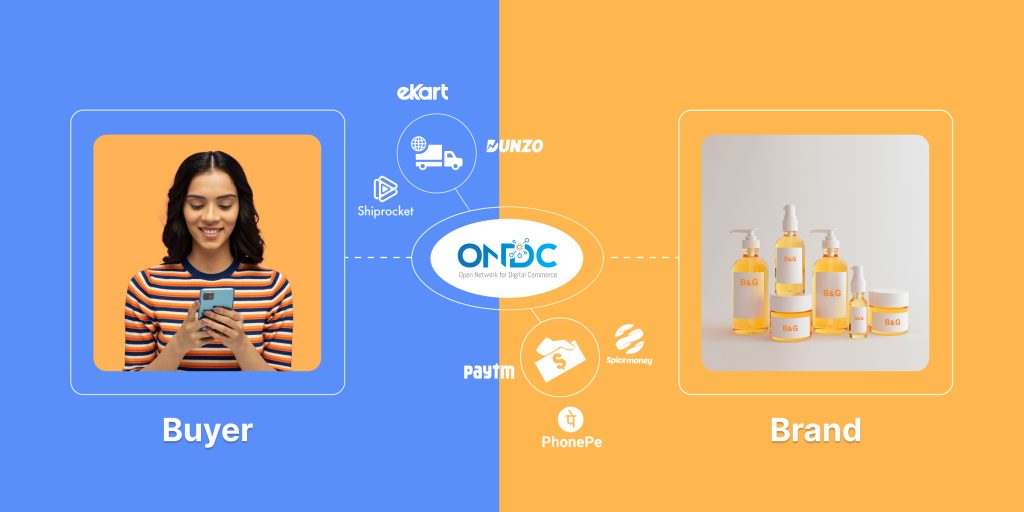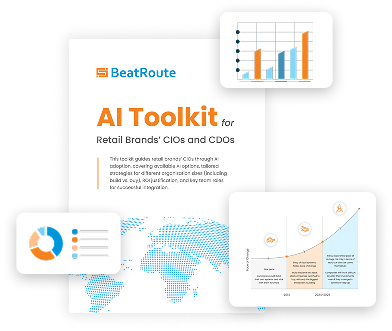Decentralised Commerce: How ONDC and D2C will Intersect to Empower CPG Brands in India

D2C is becoming the future of commerce, especially in Tier I and II cities.
Harshil Mathur (Razorpay)
D2C or direct to consumer is a trade model where the brand or manufacturer carries out commerce through their website or online store. As a brand, you enjoy more end-to-end control over aspects such as marketing and selling. Traditional retail is highly dependent on distributors, wholesalers and retailers, but the D2C model gives increased power to the brand.
The various advantages that D2C offers are:
- More power over brand image
Outside D2C, business models make the brands highly dependent on distributors and retailers to take their product to the consumer. This puts brands at a disadvantage when it comes to understanding what works and what doesn’t, hampering marketing efforts. D2C connects product owners and consumers for more transparency and can do away with everything in between.
- More room for innovation
Retailers aren’t loyal to a specific brand and may not push products to consumers, especially if it’s a new brand. This can lead to slow sales, even compelling brands to mould their products according to perceived expectations. D2C eliminates this dependency, enabling a brand to release a product on a limited scale to gauge consumer reactions and initial sales, opening the door to innovation.
- A much better margin
In B2C, products reach the end-customer via a distribution network and retailers. Retailers buy from brands at a discount or special offers, and sell the same products at a higher rate. Eliminating retailers from the equation means brands can sell their products at retail price, positively boosting their bottom line.
- Loyalty from better relationships
Unfiltered knowledge about what consumers are going for allows D2C brands to develop targeted marketing strategies for more sales and retention. With greater autonomy, brands are able to better align with consumer expectations, leading to faster marketing decisions and trustworthiness. Trust leads to loyalty and brand growth.
Today, India has over 800 home-grown D2C brands and saw tremendous growth during and after the pandemic, owing to a boost in internet usage and necessity. This has resulted in high revenue for many D2C startups, with some even becoming unicorns in their sectors.
At the same time, existing CPG brands are also exploring D2C model to reach customers directly. With India’s median age somewhere around 28 years and with more and more millennials and Gen Z shoppers preferring D2C, the D2C market is predicted to grow exponentially in the coming years.
What is ONDC?
Infrastructure, financial, and a host of other challenges have impeded many businesses from embracing digital commerce. This is in spite of the ever-growing use of smart devices and the internet, forcing brands to depend on aggregators like Amazon and Flipkart to sell their products.
With ONDC, the Indian government is planning to change this status quo and empower sellers with more control.
The Open Network for Digital Commerce (ONDC) was created to enable any seller to partake in e-commerce. E-commerce behemoths such as Amazon would no longer monopolise the market, resulting in a shift from the present platform-centric scenario to an open network. This means brands would get more visibility and consumer awareness without relying on platforms.
As nobody is excluded from the network, ONDC would lead to more options for consumers when making purchases. From the smallest enterprises to the largest corporations, anyone can be a part of the network. This epoch heralds the shift from an operator-controlled monolithic architecture to seller-driven decentralisation and will potentially change digital commerce in India forever.
How ONDC Ties in With D2C
CPG brands selling through or considering the D2C channel will find ONDC as an extremely potent distribution lever. The idea is to allow all businesses, irrespective of size and scale, to access consumers from anywhere. CPG brands now have the ability to reach markets previously unavailable to them and can try and make their products known across the country.
CPG brands that want to utilise ONDC to sell their products need to do the following:
- Create an account on a marketplace connected to ONDC and add GST and payment details.
- Upload product catalogues.
- Brands have multiple options for order fulfilment. If the brand has a network of company owned stores, independent retailers, wholesalers or distributors at their disposal, these can be utilised for order fulfilment to increase reach and reduce delivery time to customers. Otherwise, the fulfilment can happen from the brand’s own warehouse(s) as well.
- During order placement, customers choose from a wide range of shipping partners for delivery.
- Receive payments as per predetermined payment method.
Brands must fill out the Network Participant profile form to document their SPOC details and seller business model for ONDC.
ONDC also holds onboarding calls regularly to clarify technical and business matters. This is done to assist potential joiners to understand ONDC operations and how it aligns with brands and sellers.
According to ondc.org, business onboarding calls happen every Tuesday while technical onboarding calls occur every alternate Friday.
Benefits of ONDC For D2C Brands

Developing and then scaling a business from the ground up is a tedious process. For D2C brands, it requires knowledge of their market and a lot of strategizing to acquire and retain consumers. This is where ONDC puts brands at an advantage with its principles and model.
As a brand, you will be able to enjoy the following benefits with ONDC:
- More consumers are exposed to your brand
Putting your brand on ONDC makes your products accessible to consumers from all over India. There is no pressure to establish your brand with tons of marketing before you can expect visibility or good sales. This means you can enjoy a low customer acquisition cost and building your brand depends on having a worthwhile product.
- No more marketplace monopoly
Buyers have become conditioned with time and practice to depend on e-commerce giants like Amazon and Flipkart to purchase their favourite products. Selling on these aggregator sites does give brands access to a wide customer base at present, but they have to lose a significant percentage of their profits in the process. There is also the need to be present on multiple aggregators to reach the maximum consumers possible.
ONDC allows D2C brands to do away with these issues on monopolistic platforms. Once sellers register on an ONDC-enabled application, they break free from the limitations of monopolistic marketplaces. Once products are uploaded, consumers can easily find brands on buyer apps.
The seller app may have a plethora of useful features for brands such as payment options, logistics, and even GST-adhering invoices. There may be a small fee or commission to be paid by brands for orders via ONDC but it’s negligible compared to what they pay on monopolistic platforms.
- Faster product launches
The more you delay your product from being up for sale, the more you lose out on revenue. ONDC enables fast go-to-market for D2C companies through a simple but efficient onboarding process on ONDC-approved seller apps. Top apps may offer end-to-end solutions like email, messaging, and payment gateways to make product launch and fulfilment seamless.
- Embracing new frontiers
Although India’s digital commerce has spread to all metropolitan cities, there is untapped potential in smaller towns and cities; a consumer pool yet to be fully explored. One of the issues that acts as a major roadblock to establishing brand presence in such areas is the limited availability of technology.
For perspective, not everyone has a laptop, especially in small towns and tier 3 or tier 4 cities. But they do have mobile phones and that’s where the focus for ecommerce should be. The flipside is that to access these remote markets, brands need high-end, up-to-date solutions.
This is an exhaustive and time consuming effort that D2C companies can bypass by registering on an ONDC-approved marketplace. Some seller apps also offer an effective mobile interface to help brands monitor and manage their products while on the move.
- Trying different things
For a business just starting out or even for an established brand, a brand new product is a gamble of sorts. There is no absolute guarantee that a product will meet every expectation out there; this makes it necessary to release small batches initially to gauge customer demand and take the next decision accordingly. Deciding on a winning combination of product and market can be a major challenge and is subject to a lot of A/B testing and research. An extremely arduous task for any business.
ONDC, with its goal of empowering SMBs, Brands and little known enterprises, makes the above process significantly easier with ready access to pan-India markets with a simple registration.
To put it simply, D2C brands are able to make unique and diverse product decisions and sell in a range of markets from big cities to small towns. The wealth of data received in return in the form of feedback, suggestions, and sales is immensely helpful to brands in creating a more customer-aligned product that will potentially sell more.
Looking Ahead..
The coming years will be an equal opportunity market for all, giving buyers access to products they had no way of getting in the pre-ONDC e-commerce scenario. To put it in perspective, it is estimated that e-commerce penetration will go up from 8% to 25% via ONDC in the next two years.
Despite its great potential to change the face of digital commerce in India and even beyond, there are, of course, roadblocks such as the sheer challenge of onboarding millions of local or “Kirana” stores. The adoption campaign would have to be hyper-massive and yet, meticulous. Additionally, the already established consumer base of e-commerce platforms might be hesitant to move away from their habit of purchasing in a platform-centric scenario.
ONDC is envisioned to add more competition to the market by levelling the playing field for both new players and well-known brands. India is the perfect laboratory for this kind of experiment, owing to its geographical variety and the number of retail enterprises and local businesses vying for market share. The eyes of the world will be on India for an initial glimpse of what an open market for retail would look like.
If everything pans out and the vision behind ONDC is realised, it could be a gamechanger for digital commerce, making early adopter brands potential market leaders in the future. The open challenges for brands are to figure out their ONDC fulfilment model (warehouse vs distributors vs retailers), brand differentiation and value proposition to buyers.
Want to learn more on what ONDC could mean for your CPG brand? Read our blog: “What is ONDC and Why It is Important for Consumer Goods Companies.”
About the Author
-
Apart from being a Senior Content Writer at BeatRoute, Soham is an avid reader of science fiction and suspense novels (Doyle, Christie, Brown or anybody great!) He also dabbles in historical narratives and wonders about our place in the universe. Cosmic viewpoints, Carl Sagan, and Neil deGrasse Tyson intrigues him. When not reading, you may find him spending his weekends or after-work hours watching a fulfilling movie with his family.
Use Goal-Driven AI to Achieve Retail Sales Uplift, Today!
Join enterprises in 20+ countries that trust BeatRoute, the globally dominant AI platform for sales force automation, field sales, DMS, and eB2B
Latest Insights & Articles
Here are the most impactful articles, platform updates, ebooks and reports for you.



